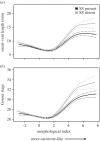Sexual selection's impacts on ecological specialization: an experimental test
- PMID: 25925102
- PMCID: PMC4424646
- DOI: 10.1098/rspb.2015.0217
Sexual selection's impacts on ecological specialization: an experimental test
Abstract
In many species, individuals specialize on different resources, thereby reducing competition. Such ecological specialization can promote the evolution of alternative ecomorphs-distinct phenotypes adapted for particular resources. Elucidating whether and how this process is influenced by sexual selection is crucial for understanding how ecological specialization promotes the evolution of novel traits and, potentially, speciation between ecomorphs. We evaluated the population-level effects of sexual selection (as mediated by mate choice) on ecological specialization in spadefoot toad tadpoles that express alternative ecomorphs. We manipulated whether sexual selection was present or reversed by mating females to their preferred versus non-preferred males, respectively. We then exposed their tadpoles to resource competition in experimental mesocosms. The resulting distribution of ecomorphs was similar between treatments, but sexual selection generated poorer trait integration in, and lower fitness of, the more specialized carnivore morph. Moreover, disruptive and directional natural selection were weaker in the sexual selection present treatment. Nevertheless, this effect on disruptive selection was smaller than previously documented effects of ecological opportunity and competitor density. Thus, sexual selection can inhibit adaptation to resource competition and thereby hinder ecological specialization, particularly when females obtain fitness benefits from mate choice that offset the cost of producing competitively inferior offspring.
Keywords: competition; disruptive selection; mate choice; resource polymorphism; speciation.
© 2015 The Author(s) Published by the Royal Society. All rights reserved.
Figures




Similar articles
-
Disruptive selection in natural populations: the roles of ecological specialization and resource competition.Am Nat. 2009 Aug;174(2):268-81. doi: 10.1086/600090. Am Nat. 2009. PMID: 19527118
-
Intraspecific adaptive radiation: Competition, ecological opportunity, and phenotypic diversification within species.Evolution. 2017 Oct;71(10):2496-2509. doi: 10.1111/evo.13313. Epub 2017 Aug 25. Evolution. 2017. PMID: 28841748
-
Character displacement as the "best of a bad situation": fitness trade-offs resulting from selection to minimize resource and mate competition.Evolution. 2005 Oct;59(10):2200-8. Evolution. 2005. PMID: 16405163
-
The evolution of female ornaments and weaponry: social selection, sexual selection and ecological competition.Philos Trans R Soc Lond B Biol Sci. 2012 Aug 19;367(1600):2274-93. doi: 10.1098/rstb.2011.0280. Philos Trans R Soc Lond B Biol Sci. 2012. PMID: 22777016 Free PMC article. Review.
-
A comprehensive overview of the effects of urbanisation on sexual selection and sexual traits.Biol Rev Camb Philos Soc. 2022 Aug;97(4):1325-1345. doi: 10.1111/brv.12845. Epub 2022 Mar 9. Biol Rev Camb Philos Soc. 2022. PMID: 35262266 Free PMC article. Review.
Cited by
-
Plasticity-led evolution: evaluating the key prediction of frequency-dependent adaptation.Proc Biol Sci. 2019 Feb 27;286(1897):20182754. doi: 10.1098/rspb.2018.2754. Proc Biol Sci. 2019. PMID: 30963848 Free PMC article.
-
Male sexual signal predicts phenotypic plasticity in offspring: implications for the evolution of plasticity and local adaptation.Philos Trans R Soc Lond B Biol Sci. 2019 Mar 18;374(1768):20180179. doi: 10.1098/rstb.2018.0179. Philos Trans R Soc Lond B Biol Sci. 2019. PMID: 30966958 Free PMC article.
References
-
- Lomnicki A. 1988. Population ecology of individuals. Princeton, NJ: Princeton University Press.
-
- Smith TB, Skúlason S. 1996. Evolutionary significance of resource polymorphisms in fishes, amphibians, and birds. Annu. Rev. Ecol. Syst. 27, 111–133. (10.1146/annurev.ecolsys.27.1.111) - DOI
-
- Pfennig DW, Pfennig KS. 2012. Evolution‘s wedge: competition and the origins of diversity. Berkeley, CA: University of California Press.
-
- West-Eberhard MJ. 2003. Developmental plasticity and evolution. New York, NY: Oxford University Press.
Publication types
MeSH terms
Grants and funding
LinkOut - more resources
Full Text Sources
Other Literature Sources

